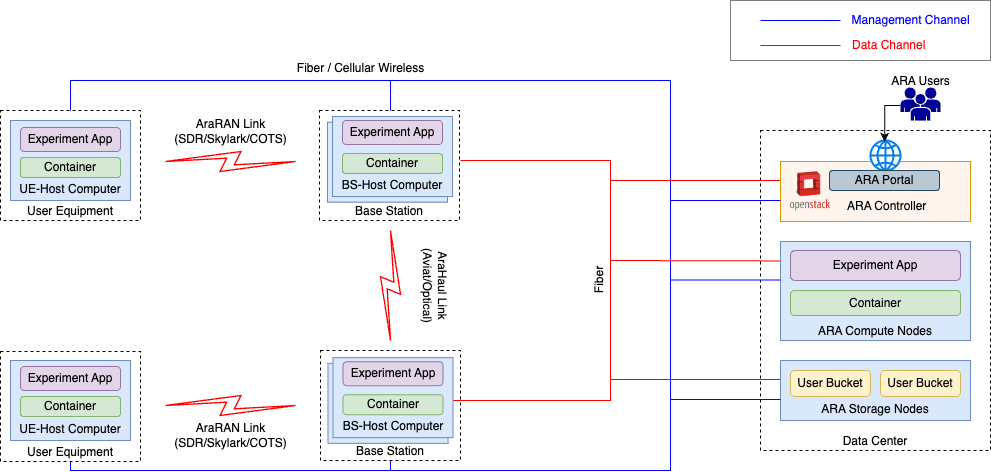ARA Software Architecture
ARA software framework, we call AraSoft, is derived from popular OpenStack cloud operating system with container-mode resource provisioning, the philosophy adopted by the CHI@Edge spin of Chameleon Cloud. Along with the typical resources such as compute and storage, ARA introduces wireless resources (including cellular base stations, user equipment, and long-range wireless backhaul) to the cloud platform for experimenters to conduct advanced wireless research. The basic architecture of AraSoft is shown below.

As far as the deployment is concerned, ARA includes a data center (with compute and storage resources) and different sites equipped with wireless resources (such as RAN base stations and user equipment, as well as wireless backhaul). Data center maintains the ARA controller providing a web-portal where the user logs in, reserves the resources (compute, storage, base stations, and user equipment), and performs the experiments. In addition to the controller, data center is equipped with dedicated compute nodes for users to perform computation operations or to run experiments that do not require specific type of nodes. Along with the compute, ARA is equipped with storage nodes to provide users an additional space for storing their data.
Each ARA site consists of a single server or multiple servers hosting the wireless devices including RAN and wireless backhaul radios. When a user reserves a resource, say base station, the associated host computer is allocated so that the user can launch containers and access the wireless resource. Further, a console access is provided to the container via the portal or via Secure Shell (SSH) protocol using the floating IP feature as discussed in the Hello World Experiment. On accessing the container, the user can execute their experiments. The workflow of experiment is shown in the figure below.

ARA controller communicates to all physical resources via the management channel (shown in Blue color in the figure above) through optic fiber or cellular wireless channel. Controller uses the management channel to provide users the access to their containers. In addition, by default, the containers themselves communicate via virtual networks created over this management channel. For example, if you launch Container-A at Curtiss Farm base station and Container-B at a Curtiss Farm user equipment, they communicate via a virtual network over the management channel. On the contrary, if you run a 5G protocol stack on the containers (say gNB at Container-A and UE software at Container-B), they establish a wireless link via the data channel (shown in Red color) and use that network for communication. As shown in the figure, ARA is equipped with long-range wireless backhaul communication between base stations (i.e., between Wilson Hall and Agronomy Farm in the current deployment) and users are allowed to perform their experiment on the backhaul similar to any access network experiments. The experiment data from base station or user equipment can be transferred to a container in the data center compute nodes for further processing.